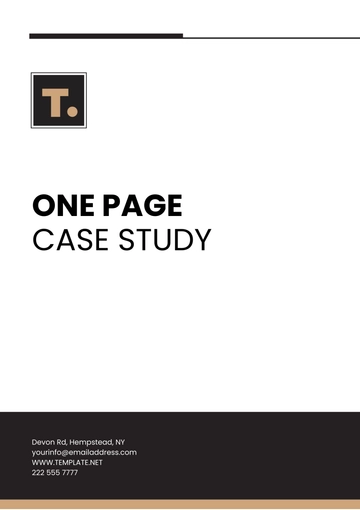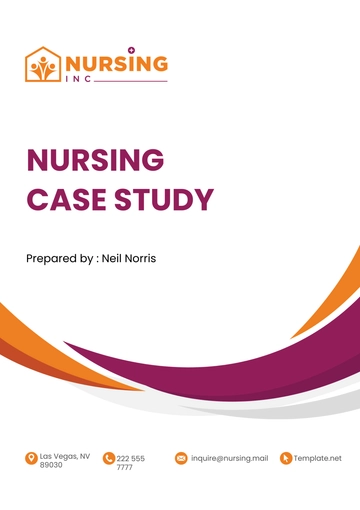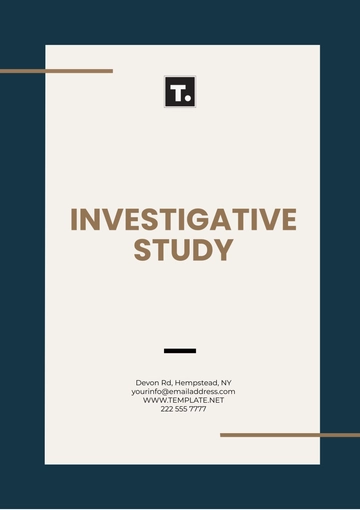Free International Marketing Case Study

I. Introduction
The introduction section provides an overview of the International Marketing Case Study, including the background, objectives, and scope of the study. It sets the stage for understanding real-world scenarios or situations related to international marketing strategies, challenges, successes, or failures. This section typically includes:
1.1 [Your Company Name] Background:
Brief history and overview of the company's operations in international markets.
Market segments targeted and key products/services offered globally.
1.2 Objectives of the Case Study:
Clearly defined goals and purposes of conducting the case study.
Specific areas of international marketing are to be analyzed and examined.
1.3 Scope of the Study:
Geographical regions or countries covered in the case study.
Timeframe or period under consideration for the analysis.
II. Methodology
The methodology section outlines the research approach, data sources, and analytical techniques used to conduct the International Marketing Case Study. It provides transparency regarding how the information was gathered, analyzed, and interpreted. This section may include:
2.1 Research Design:
Description of the study design, whether it's a qualitative or quantitative approach.
Explanation of any tools or frameworks utilized for data collection and analysis.
2.2 Data Collection:
Sources of primary data (e.g., interviews, surveys, observations) and secondary data (e.g., industry reports, market data).
Sampling methods are employed to select relevant cases or participants.
2.3 Data Analysis:
Techniques used for data analysis, such as thematic analysis, statistical analysis, or content analysis.
Steps were taken to ensure data validity, reliability, and triangulation.
III. Case Background
The case background section provides detailed information about the real-world scenario or situation under examination. It delves into the specific international marketing challenges, successes, or failures faced by the company or organization. This section may include:
3.3 Market Entry Strategy:
Description of the company's initial entry into international markets.
Factors influencing the choice of market entry mode (e.g., exporting, joint venture, licensing).
3.4 Marketing Strategies:
Overview of marketing strategies employed in international markets (e.g., product adaptation, pricing strategies, promotional campaigns).
Analysis of competitive positioning and market share in different regions.
3.5 Challenges Faced:
Identification and analysis of key challenges encountered in international marketing efforts (e.g., cultural barriers, regulatory issues, competitive landscape).
Impact of external factors (e.g., economic fluctuations, geopolitical events) on marketing strategies.
IV. Results and Findings
The results and findings section presents the outcomes of the International Marketing Case Study, highlighting key insights, trends, and lessons learned from the analysis. It includes:
4.1 Market Performance:
Performance metrics and indicators used to evaluate market success (e.g., sales growth, market penetration, customer feedback).
Comparison of performance across different international markets.
4.2 Success Factors:
Factors contributing to successful international marketing initiatives (e.g., strategic partnerships, market segmentation, localization strategies).
Case examples of successful campaigns or market expansion efforts.
4.3 Lessons Learned:
Key takeaways and lessons learned from the case study analysis.
Recommendations for improving future international marketing strategies.
V. Conclusion and Recommendations
The conclusion and recommendations section summarizes the main findings of the case study and provides actionable recommendations for [Your Company Name] or other organizations operating in international markets. It includes:
5.1 Summary of Findings:
Recap of the main findings and insights gained from the case study analysis.
Identification of strengths, weaknesses, opportunities, and threats (SWOT analysis) related to international marketing.
5.2 Recommendations:
Specific recommendations for [Your Company Name] to enhance its international marketing effectiveness (e.g., market expansion strategies, cultural adaptation tactics, digital marketing innovations).
Generalizable recommendations for other companies facing similar challenges in international markets.
5.3 Implementation Plan:
Proposed steps and timelines for implementing the recommended strategies and initiatives.
Key performance indicators (KPIs) to measure the success of implementation efforts.
VI. References
The references section includes a list of all sources cited and consulted during the preparation of the International Marketing Case Study. It follows a standardized citation style (e.g., APA, MLA) and includes:
Academic journals, books, and research articles.
Industry reports and market analysis publications.
Official company documents and websites.
Prepared By:
[Your Name]
[YOUR POSITION]
[YOUR DEPARTMENT]
Contact Details:
[Your Email]
[Your Company Number]
[Your Company Website]
[Your Company Address]
- 100% Customizable, free editor
- Access 1 Million+ Templates, photo’s & graphics
- Download or share as a template
- Click and replace photos, graphics, text, backgrounds
- Resize, crop, AI write & more
- Access advanced editor
Discover the International Marketing Case Study Template on Template.net for detailed international marketing analysis and reporting. This editable and customizable template empowers marketers to document international marketing strategies comprehensively. Utilize our AI Editor Tool to tailor the case study effortlessly, ensuring clear and insightful international marketing analysis. Simplify your international marketing case studies with this user-friendly and professional template.





























